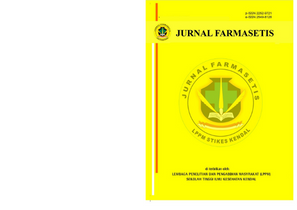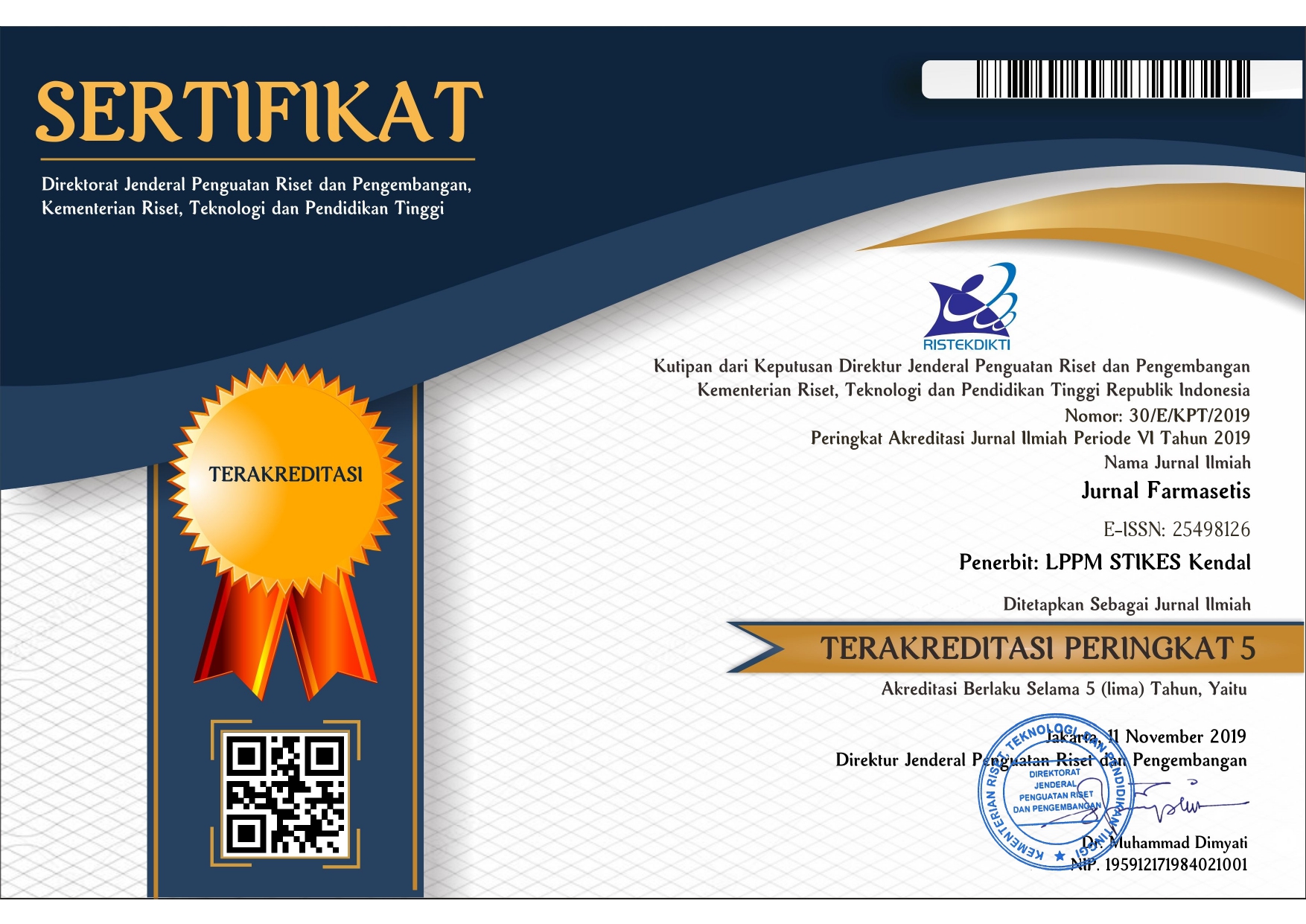Uji Aktivitas Antiglikasi Granul Effervescent Kombinasi Ekstrak Brokoli (Brassica oleracea var. Italica) dan Buah Pare (Momordica charantia L)
DOI:
https://doi.org/10.32583/far.v13i4.2543Keywords:
brokoli, effervescent, glikasi, pareAbstract
Glikasi adalah reaksi non-enzimatik antara gugus amino bebas dan gugus karbonil gula pereduksi membentuk Advanced Glycation End Products sebagai produk akhir. Terjadinya glikasi disebabkan oleh hiperglikemia .Antiglikasi merupakan zat yang dapat menghambat terjadinya reaksi glikasi . Ekstrak Brokoli (Brassica oleracea var. Italica) .dan buah Pare dapat penghambat pembentukan AGEs sehingga berpotensi sebagai Antiglikasi dari bahan alam. Penggunaan bahan alam sebagai zat aktif dalam pembuatan produk harus diformulasikan dengan baik supaya dapat meningkatkan ketertarikan dan kemudahan dalam penggunaannya oleh masyarakat. Formulasi granul effervescent menghasilkan efek karbonisasi yang memberikan kesegaran dan dapat menutupi rasa khas dari kedua bahan ini. Tujuan dari penelitian ini adalah mengetahui Aktivitas Antiglikasi Granul Effervescent Kombinasi Ekstrak Brokoli (Brassica oleracea var. Italica) dan Buah Pare (Momordica charantia L). Metode penelitian dilakukan dengan cara maserasi menggunakan etanol 70%. Hasil ekstrak kental yang telah didapatkan dilanjutkan dengan formulasi granul effervescent dengan tiga kombinasi yang berbeda-beda yaitu formula satu 5%, formula dua 7,5% dan formula tiga 10%. Penentuan Aktivitas Antiglikasi dilakukan dengan metode Spektrofofometri pada panjang gelombang 450 nm dengan IC50 sebagai besaran penunjuk. Berdasarkan hasil penelitian didapatkan bahwa antiglikasi formula 1 didapatkan IC50 120,325 ppm, formula dua IC50 95,3184 ppm dan formula tiga dengan IC50 82,8158 ppm.
References
Adisakwattana, S., et al. (2012). "Asam Sinamat dan Turunannya Menghambat Glikasi Protein yang Dimediasi Fruktosa." Jurnal Molekuler, 13(2), 1778–1789.
Ali, F., et al. (2016). "Synergistic effects of plant extract combinations on antiglycation and antioxidant activities." Journal of Medicinal Plants Research, 10(19), 264-273.
Bhatia, M., et al. (2013). "Development and evaluation of effervescent tablets: A review."Journal of Pharmaceutical Sciences and Research, 5(3), 59-66.
Das, S., et al. (2016). "Formulation and evaluation of effervescent tablets containing flavonoids and phenolics from plant extracts." Journal of Pharmacognosy and Phytochemistry, 5(3), 171-175.
Estikawati, I., & Lindawati, N. Y. (2019). "Penetapan Kadar Flavonoid Total Buah Oyong (Luffa Acutangula (L.) Roxb.) dengan Metode Spektrofotometri UV-Vis." Jurnal Farmasi Sains Dan Praktis, V(2).
Esa, N. M., Ling, T. B., & Peng, L. S. (2013). "Antiglycation and antioxidant properties of broccoli (Brassica oleracea L.) extracts in vitro." International Journal of Food Sciences and Nutrition, 64(2), 280-286.
Fahey, J. W.et al (2010). "Sulforaphane inhibits extracellular, but not intracellular, formation of advanced glycation end-products: relevance for diabetic complications." Journal of Nutrition, 140(9), 1717-1722.
Hanani, H. (2017). Assessment of phenolic content and antioxidant activity of selected vegetables. Food Chemistry, 229, 309-316.
Houghton,et al. (2009). "The role of sulforaphane in the management of oxidative stress." Journal of Ethnopharmacology, 123(3), 459-470.
Horax, R., et al (2010). "Total phenolic contents and phenolic acid composition of three varieties of bitter melon (Momordica charantia) and antioxidant activities of their extracts." Journal of Food Science, 75(8), C620-C626.
Hsu,et al. (2011). "Antidiabetic and antiglycation effects of Momordica charantia in an experimental model of diabetes." Phytotherapy Research, 25(4), 576-582.
Hussein, et al. (2015). "Effervescent tablets: A review of preparation and quality control." Asian Journal of Pharmaceutical Sciences, 10(1), 1-8.
Hussain.et al..,(2017). Inhibitory effects of natural and synthetic compounds on advanced
glycation end products (AGEs) formation and their potential therapeutic implications. Journal of Biomedical Science and Engineering, 10(7), 269-283.
Junjun Liu ,et al,2021 Novel advances in inhibiting advanced glycation end product formation using natural compounds , Volume 140, 111750
Jung, et al. (2017). "The role of dietary antioxidants in the prevention of diabetes and its complications." Nutrition Reviews, 75(3), 184-196.
Kondoj ,et al. (2018). "Aktivitas Antifotooksidasi Dan Penghambat Pembentukan AGEs (Advanced Glycation End-Products) Dari Fraksi Alga Padina australis." Pharmacon, 7(4), 51–61.
Koyama, K., & Kida, K. (2019). Anti-glycation effects of broccoli sprouts extract and its major component sulforaphane in vitro. Journal of Functional Foods, 55, 60-68
Kutner, M. H., Nachtsheim, C. J., Neter, J., & Li, W. (2004). Applied linear statistical models (5th ed.). McGraw-Hill.
Kusznierewicz, B., et al. (2008). "The effect of heating and fermenting on antioxidant properties of white cabbage." Food Chemistry, 108(3), 853-861.
Rahman, S., Akhtar, S., & Jamal, S. (2017). "Antiglycation potential of natural products and their therapeutic role in prevention of AGEs mediated diabetic complications." Food and Chemical Toxicology, 110, 420-433.
Rungapamestry, et al (2007). "Effect of broccoli and its constituents on the formation of advanced glycation end-products in vitro." Journal of Nutritional Biochemistry, 18(7), 429-434.
Singh, et al. (2014). "Advanced glycation end-products and their role in aging and diabetes." Current Diabetes Reports, 14(9), 537
Suryanto, E., & Taroreh, M. (2020). "Aktivitas Antioksidatif Dan Anti-Glikasi Ekstrak Fenolik Bebas Dan Fenolik Terikat Dari Tongkol Jagung." Chemistry Progress, 13(2).
Wong, T. C., et al. (2016). "The impact of effervescent formulations on drug dissolution and absorption." Drug Delivery, 23(4).
Downloads
Published
How to Cite
Issue
Section
License
Copyright (c) 2024 Suharyanto Suharyanto, Dzaki Fikri, Hartono Hartono

This work is licensed under a Creative Commons Attribution-NonCommercial-NoDerivatives 4.0 International License.







